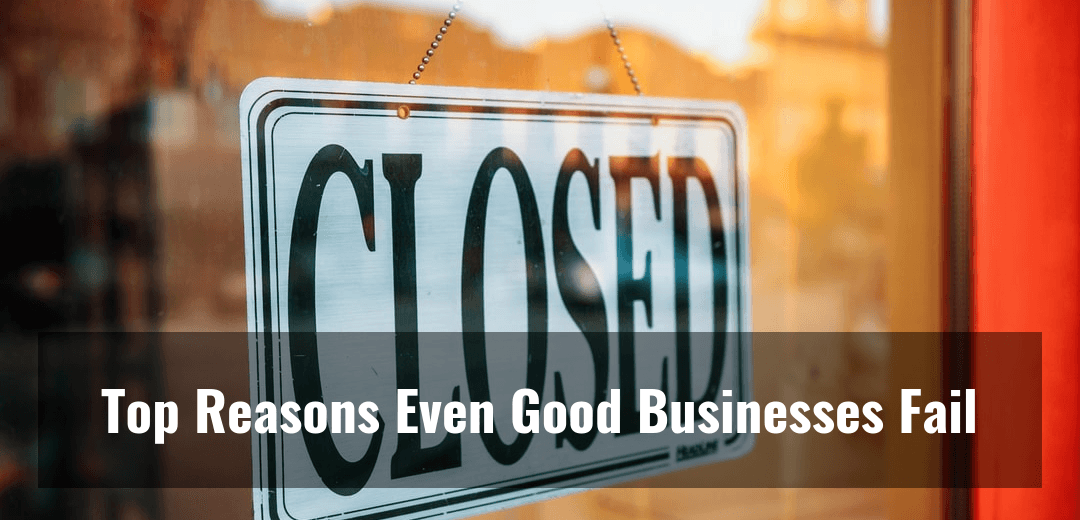7 Reasons Why Businesses Fail — Even When They Appear to Be Doing Well

It's not just start-ups that fail, many once successful businesses don't make it past 10 years.
The history of business is full of stories of high-flying public companies that come crashing to the ground. The warning signs were evident, but investors often ignored the signs. Privately owned businesses may not have the same pressures, but good businesses can fail as easily as the fast growth businesses. Let's explore the reasons that good businesses can fail.
Business failure is a harsh reality, and it’s not only reserved for start-ups and small businesses, but also large enterprises. We have seen big, once-successful companies fail — some going bankrupt and others reduced in size substantially.
But why?
Well, at the surface level, business failure can be attributed to cash flow problems — the cracks start well before that brutal period of financial collapse. Many companies tend to feel invulnerable until an unexpected event, like a pandemic, turns their world over.
According to data from the U.S. Bureau of Labor Statistics, about 20 percent of small businesses fail within their first year. By the end of their fifth year, roughly 50 percent of small businesses fail. After 10 years, the survival rate drops to approximately 35 percent.
What’s interesting about these figures is that the rates of failure are fairly consistent. Even during the economic downturn, failure rates didn’t skyrocket. They remained steady, suggesting that economic factors don’t have as significant an impact on the success of small business survival as many may think.Tom Sumrak, Lending Tree
No business is immune to challenges that, if not handled well, can lead to closure. Read on and find out some of the main reasons why many companies decline, and what can be done to avoid it.
Why Do Businesses Fail?
Recent data shows that 70% of businesses will fail within their first 10 years of operation (which is an improvement over earlier studies where only 96% of businesses made it past the 10 year mark).
Reason # 1 - High Growth
We’ve all watched businesses rise to the level of economic giants outdoing long-enduring companies and gaining popularity faster than they can endure. But with time, these businesses crumble down like a house of cards. Why?
Believe it or not, business failure can be due to high growth — it is a virtue and a vice at the same time.
Some businesses may outgrow their performance and decline because they are not able to sustain themselves. Companies may overspend in areas that lead to high business growth without having the foundation to support it. As a result, because of being over focused on growth, they end up falling back, exhausted, and underperforming.
According to some studies, as many as 60% of the fastest growing companies will fail.
One good example is Zynga, who once dominated the social gaming market. While the company still exists, despite investing $100 million in it's own data center, it's no longer the giant it once was.
Growth is key to any business, but it needs to focus on strategies that are geared towards sustainable growth. This could mean diversifying in the product and the market. What may have led to that growth a year ago isn’t necessarily what will lead to better results in the future.
Reason # 2 - Over Dependence on Strengths and Past Ideas
Who does not like leveraging on the advantages of their business and the team?
After all, many companies find it easier executing what has worked before, as well as what one knows as opposed to following a new path that could lead to something new. What many business leaders forget is that whatever worked yesterday won't necessarily work today.
Relying on the past is likely to cause a company to struggle.
When you don't innovate, other businesses who are doing it right will pass you by. The most obvious examples are the brick-and-mortar booksellers that shut their doors because they couldn't keep up with Amazon. More recently, we saw Toys R Us, who at one time was THE name in the retail toy industry, file for bankruptcy. Similarly, Kodak, which failed to embrace the digital age, despite having many opportunities to change course.
For businesses to benefit from sustained growth, they have to find a way of fostering new capabilities without exhausting the employees. This means coming up with new growth-oriented routines that make scaling achievable.
The right way around this could be through shifting roles and responsibilities within the employees. This strategy not only helps in building teamwork and collaboration but also merges strengths and conserves energy.
Reason # 3 - Not Investing in Recovery
Building a business or even a new brand within a company is never an easy task. Not especially when you are launching a new product, venturing in a new market, or even staying ahead of the upcoming competition, not forgetting to adapt to the ever-changing client needs.
It is at this point that the business outstretches its resources, especially the human resource, for more productivity in a bid to meet the target. Some workers may find it hard keeping up with the performance standards expected of them and end up being less productive. Much as training is essential, recovery is critical. We perform better when we recover.
Leading companies like Google LLC and also Johnson & Johnson place high importance on recovery, as can be seen by the design of the workplace. These companies understand the importance of recovery in getting the desired results. Google has been known to train its employees on using different types of work spaces in a bid to manage their energy levels.
Reason # 4 - Lack of Long-Lasting Value
One of the critical avenues that perhaps lead to both accelerated growth and also dominance in the market is lasting value. It could be an exceptional delivery of products, including steady production as well as the steady improvement of these goods and services.
A company which has been in existence for years begins to crumble when it starts to under-deliver or even sustain its quality and dominance in the market.
A good business knows how to maneuver its resources most productively, which includes investing in the labor force. They empower all employees across the board with knowledge and skills that improve their well-being both at home and also at work.
Reason # 5 - Not Investing in the Labor Force
If the CEO is the brains behind any business, and the Board is the backbone, then the employees are the limbs which drive the success of the company. None can work without the other. Businesses collapse when these are not working together.
You will find companies that pay well for top-level positions at the expense of the other employees. These executives get great packages and benefits that the low-level employees who drive the company brand never see. When it comes to empowerment, the top-level executives come first, with the rest often forgotten or unaccounted for.
The result is a misplaced focus as the company resources are directed towards initiatives and activities that don’t bring value to the business.
A good business knows how to maneuver its resources productively, which includes investing in the labor force. They empower employees with knowledge and skills that improve their well-being both at home and also at work.
Reason # 6 - High Employee Turnover
High employee turnover could mean something is wrong with your business.
Many companies will fail because nothing is being done to curb the issue.
A simple step like getting employee feedback and engaging them on various occasions to find out about their well-being could mean all the difference for your company regardless of how long you’ve been up and running.
Reason # 7 - Lack of Proper Strategic Planning
Strategic planning needs to be thought of as an on-going process, not just something you do once a year. Or worse yet, only at the launch of a new business.
Revisiting your strategic plan is important to ensure that takes into consideration changes within the marketplace.
Frequently businesses have strategic plans that are not aligned with their actual business model. One common reason for this is not having a clear understanding of the difference between an operational plan and a strategic plan.
With an effective, and well-thought out strategic plan, many of the other issues can be avoided. Or at least you will be prepared to handle them when the do happen.
Wrapping Up - Fewer Business Failures
Should your business be showing any of the signs that we have described, perhaps it is time that you start reflecting on where it is headed.
Is your business pacing for growth or a downfall?
When you master the art of maintaining focus, investing in your company’s labor force as well as investing in recovery for your team, then you will have nothing to fear.
One way to ensure that your business has the best chances of success, especially if your company does not have its own Chief Financial Officer, is to utilize outsourced CFO services.
With a fractional CFO, you get an outside perspective of your business, but with the right person, you get a higher level of talent, without the costs associated with a full-time hire.
Results in a Day!
Not ready for a long-term engagement but still need help with getting your business headed in the right direction? Then a one-day, strategic planning session with you and your staff is the way to go.
